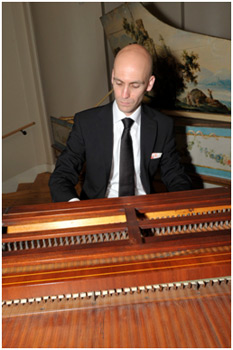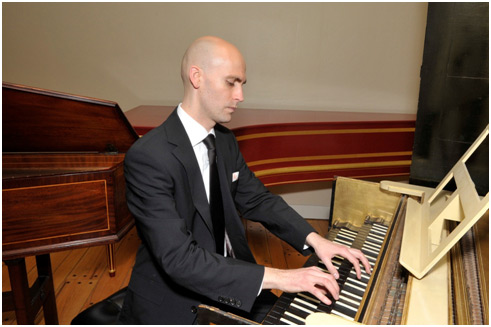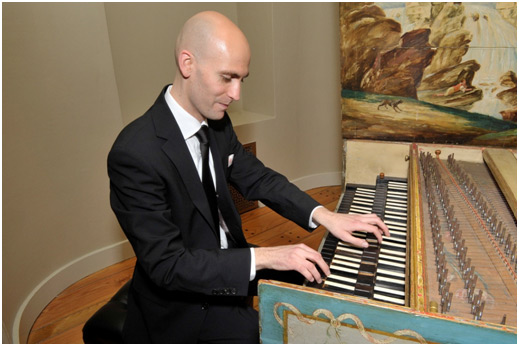- Home
- About
- About SCMS
- Directors
- Artists
- Vera Beths
- Steven Dann
- Marc Destrubé
- James Dunham
- Mark Fewer
- Eric Hoeprich
- Christopher Krueger
- Myron Lutzke
- Marilyn McDonald
- Douglas McNabney
- Mitzi Meyerson
- Pedja Muzijevic
- Anca Nicolau
- Jacques Ogg
- Loretta O'Sullivan
- Lambert Orkis
- Paolo Pandolfo
- William Purvis
- Marc Schachman
- Jaap Schröder
- Andrew Schwartz
- William Sharp
- Ian Swensen
- Lucy van Dael
- Ensembles
- Concerts
- The Collection
- Recordings
- Education
- Donate

Erin Helyard at the keyboard of the 1794 Broadwood piano
On Thursday 27 May 2010, the Smithsonian Chamber Music Society, in conjunction with the Westfield Center and the Music Division of the Library of Congress, hosted another fascinating keyboard evening in the Hall of Musical Instruments. Australian harpsichordist/fortepianist Erin Helyard, recently named the Westfield Concert Scholar for 2009-2010, presented a program entitled: “Could only be performed by the author himself or the Devil: Clementi from Dorset to London.” (Since its foundation in 1979, The Westfield Center—www.westfield.org—has been recognized for its extraordinary conferences and workshops, its presentation of excellent performances, and its leadership in the promotion of keyboard music. The Concert Scholar Program is designed to give talented young keyboard players in the early stages of their career an opportunity to perform on excellent instruments located throughout the country.) This concert was attended by members of AMIS (the American Musical Instrument Society—www.amis.org), which was holding its 39th annual meeting at the Library of Congress.

Helyard playing the 1745 Dulcken harpsichord
Helyard’s program, which he performed on three different instruments from the Smithsonian collection (the 1745 Johannes Daniel Dulcken Flemish harpsichord, the 1760 Benoit Stehlin French harpsichord, and the 1794 John Broadwood English fortepiano), contained a Handel Chaconne, two Scarlatti sonatas, a sonata by Pietro Domenico Paradies, and five compositions by Muzio Clementi. These latter proved that the composer of so many keyboard exercise which have vexed students for two centuries could also write brilliant, touching, and thoroughly accomplished concert pieces. Mr. Helyard’s notes (©2010) for the program describe its content:
Muzio Clementi’s life is in many respects a microcosm of the great changes that took place across Europe during the Industrial Revolution. In his early life he was bought of his family in a feudal arrangement by an English aristocrat; in his later life he was one of England’s greatest capitalists. Sir Peter Beckford, travelling through Rome on the Grand Tour in 1766, discovered the talented fourteen-year-old and made arrangements with Clementi’s father, a silversmith, to take him back to England. There Clementi “devoted eight hours a day to the harpsichord” in the isolation of Beckford’s estate in rural Dorset, more than a day’s journey on horseback from the centre of London. Here he “practiced and studied continually” the works of Scarlatti, Paradies, Handel and the Bachs. Clementi now found himself in a provincial situation that must have contrasted greatly with Rome; but at least it appears that His Lordship had a decent library. Apparently Clementi’s performances of Scarlatti sonatas were legendary: “I have never heard anyone play the sonatas of Domenico Scarlatti as he does,” a correspondent wrote in 1784, “until now I only half knew them.” The English environment and Sir Peter Beckford seem to have provided him with the unprecedented freedom to follow his own musical interests and intellectual passions.
When Clementi finally moved from Dorset to London around 1775, he brought with him an unparalleled keyboardistic technique, based largely on the rapid thirds, octaves and hand-crossings found in Scarlatti’s works. Unusually, Clementi did not immediately begin to show off his skills once ensconced in London. Instead, he conducted the opera from the harpsichord at the King’s Theatre for a few years; an ideal position to judge discreetly and directly from the arena of action the English audience’s seemingly unpredictable taste for novelty. Clementi thus lay in wait, judging his most opportune moment. It was in 1779, and at the age of twenty-seven, when he struck. If his Opus 1, commonplace sonatas dedicated to Beckford, can be seen to constitute a farewell to the provincialism of Dorset, then Opus 2 of that year is a big hello to the heady cultural extremes of Europe’s largest and most cosmopolitan city. This well timed moment of print and performance constitutes an act of entrepreneurial flair that would characterize Clementi’s career well into the nineteenth century. Opus 2 became immediately popular and their notoriously difficult passages established Clementi’s reputation as a virtuoso. Press surrounding Opus 2 assured its readers that the works “could only be performed by the author himself or the Devil.”
The second part of this recital is dedicated to those large works of the 1790s and 1800s that were published when Clementi’s career was at its height. After initial dealings with Longman & Broderip in 1798, Clementi eventually bought out his partners to form the music-publishing and piano-manufacturing firm that became known as Clementi & Co. It was during this period of economic consolidation that Clementi embarked on the revision of many of his earlier works as well as publishing and promoting grand sonatas in his “better style,” as he once described it. The Capriccio in A (Op. 34 No. 1) is a work that suggests Clementi’s formidable skill as an improviser. Essentially an open-ended movement in sonata form, the work was “revised and improved” by Clementi on a sojourn in Leipzig, when he was overseeing the publication by Breitkopf & Härtel of his Oeuvres Complettes [sic]. The variations on the popular tune of “Lison dormait dans un bocage” also reveal the composer’s improvisatorial bent, and reveal simultaneously an interest in canonic techniques as well as a flair for new pianistic textures and timbres. One of his greatest sonatas, Op. 34 No. 2, has been consistently singled out by commentators for its masterly formal cohesion across all three movements. Clementi’s predilection for sophisticated motivic and contrapuntal play seems to have struck a chord with young composers like Beethoven, who like his continental contemporaries was fascinated with the well-advertised and strategically marketed products of English culture. And these were not only Clementi sonatas, but English pianos, gardens, fashion, military technology, furniture, porcelain, and interior design. For it was not only the Industrial Revolution that was fostered in England; many facets of what would later be called Romanticism can also be first discerned in that country’s philosophy, literature, and music.

Helyard playing the 1760 Stehlin harpsichord


